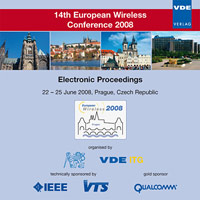IEEE 802.11s – Mesh Deterministic Access
Konferenz: European Wireless 2008 - 14th European Wireless Conference
22.06.2008 - 25.06.2008 in Prague, Czech Republic
Tagungsband: European Wireless 2008
Seiten: 8Sprache: EnglischTyp: PDF
Persönliche VDE-Mitglieder erhalten auf diesen Artikel 10% Rabatt
Autoren:
Hiertz, Guido R.; Max, Sebastian; Junge, Thomas (Chair of Communication Networks, Faculty 6, RWTH Aachen University, Aachen, Germany)
Denteneer, Dee (Philips, Eindhoven, The Netherlands)
Berlemann, Lars (Swisscom, Bern, Switzerland)
Inhalt:
In 2003, interests in the Institute of Electrical and Electronics Engineers (IEEE) 802.11 Working Group (WG) led to formation of Task Group (TG) “S”. 802.11s develops an amendment for Wireless Local Area Network (WLAN) Mesh. Unlike existing WLAN Mesh products, 802.11s forms a transparent 802 broadcast domain that supports any higher layer protocols. Therefore, 802.11s provides frame forwarding and path selection at layer-2. While traditional WLANs are Access Point (AP) centered, the WLAN Mesh is fully distributed. Hence, 802.11s considers extensions to the Medium Access Control (MAC) too. The current draft 2.0 of 802.11s denotes the optional MAC as Mesh Deterministic Access (MDA). Due to the high amount of indirect neighbors in a WLAN Mesh, the current single-hop medium access control mechanisms cannot operate efficiently. In contrast, unlike traditional listen-before-talk scheme MDA’s advanced medium reservation scheme allows for operation free of collisions. Therefore, MDA enables support for Quality of Service (QoS) and provides more capacity in the WLAN Mesh. In this paper, the authors, who have contributed to the standardization of 802.11s since 2003, give insight to the basics of draft 2.0 of 802.11s and its principles. Furthermore, we provide detailed simulation results of 802.11’s first WLAN Mesh aware MAC: MDA. Our simulation results show that unlike the traditional Enhanced Distributed Channel Access (EDCA), MDA does not stall when the offered traffic is high. Due to its planned medium access, limited packet delay can be achieved.


